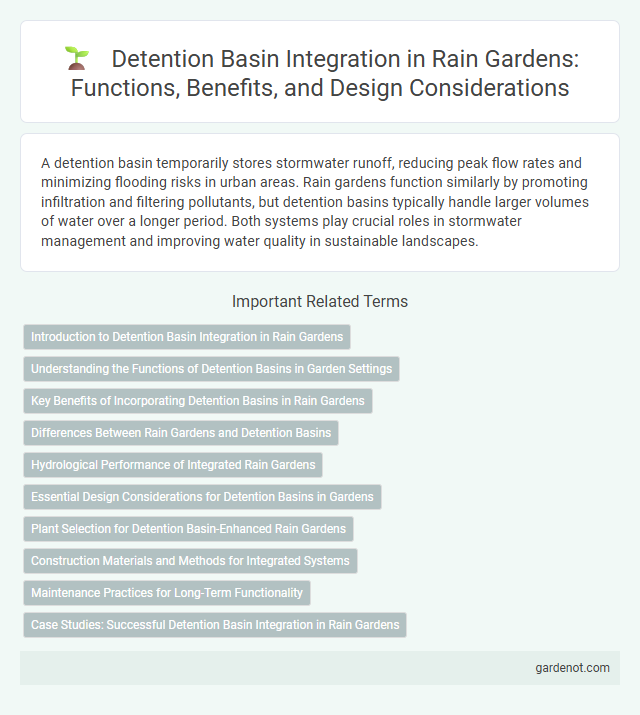A detention basin temporarily stores stormwater runoff, reducing peak flow rates and minimizing flooding risks in urban areas. Rain gardens function similarly by promoting infiltration and filtering pollutants, but detention basins typically handle larger volumes of water over a longer period. Both systems play crucial roles in stormwater management and improving water quality in sustainable landscapes.
Introduction to Detention Basin Integration in Rain Gardens
Detention basins are engineered structures designed to temporarily hold stormwater runoff, reducing peak discharge and improving water quality before infiltration in rain gardens. Integrating detention basins within rain gardens enhances flood control by managing excess water during heavy rainfall events, promoting groundwater recharge and reducing urban runoff impact. These hybrid systems optimize stormwater management in urban landscapes by combining storage capacity with natural filtration processes.
Understanding the Functions of Detention Basins in Garden Settings
Detention basins temporarily hold stormwater runoff, controlling the flow rate to prevent flooding and erosion in garden settings. These basins promote water infiltration and improve water quality by allowing sediments and pollutants to settle before the water slowly releases into the environment. Properly designed detention basins support garden health by managing excess water and reducing stress on surrounding plants and soil structures.
Key Benefits of Incorporating Detention Basins in Rain Gardens
Detention basins in rain gardens effectively manage stormwater by temporarily holding runoff, reducing flood risk and downstream erosion. These basins enhance water quality by promoting sedimentation and pollutant decomposition before water infiltrates into the soil. Incorporating detention basins supports groundwater recharge and helps maintain natural hydrological cycles in urban environments.
Differences Between Rain Gardens and Detention Basins
Rain gardens are shallow, vegetated basins designed to enhance infiltration and support native plants, whereas detention basins are engineered structures primarily intended to temporarily store stormwater and control peak runoff rates. Unlike rain gardens, detention basins typically have impervious or compacted soils and lack the dense planting necessary for pollutant removal and groundwater recharge. The key operational difference lies in rain gardens' emphasis on water infiltration and ecological benefits, while detention basins focus on flood mitigation and stormwater quantity management.
Hydrological Performance of Integrated Rain Gardens
Detention basins in integrated rain gardens significantly improve hydrological performance by temporarily storing stormwater runoff and facilitating gradual infiltration, reducing peak discharge rates and downstream flooding risks. These systems enhance groundwater recharge while filtering pollutants through vegetation and soil media, promoting sustainable urban water management. Optimizing detention basin design within rain gardens supports stormwater control measures that comply with regulatory requirements and improve overall watershed health.
Essential Design Considerations for Detention Basins in Gardens
Detention basins in rain gardens require precise sizing based on peak stormwater runoff to effectively mitigate flooding and erosion. Incorporating permeable soil layers and overflow outlets enhances water infiltration and prevents basin overtopping during heavy rainfall. Vegetation selection must prioritize native, water-tolerant plants to stabilize soil, promote evapotranspiration, and support local biodiversity within the detention basin.
Plant Selection for Detention Basin-Enhanced Rain Gardens
Selecting appropriate plants for detention basin-enhanced rain gardens ensures effective stormwater management and improved water quality. Native species like swamp milkweed, blue flag iris, and joe-pye weed offer deep root systems that enhance soil infiltration and pollutant removal. Choosing drought-tolerant and flood-adapted plants optimizes basin resilience, reduces maintenance, and supports local biodiversity.
Construction Materials and Methods for Integrated Systems
Detention basins in rain garden systems utilize permeable materials such as engineered soils, gravel layers, and geotextiles to enhance water infiltration and temporary runoff storage. Construction methods emphasize layering these materials to create a balance between water retention and slow release, with compacted subsoils to prevent premature seepage. Integrated systems often incorporate modular infiltration chambers and vegetation to support pollutant removal and maintain structural stability.
Maintenance Practices for Long-Term Functionality
Regular inspection and removal of sediment and debris are essential maintenance practices for detention basins to ensure their long-term functionality in rain garden systems. Vegetation management, including trimming and replanting native species, helps maintain infiltration rates and prevents erosion. Periodic assessment of inlet and outlet structures guarantees proper water flow, reducing the risk of flooding and structural damage.
Case Studies: Successful Detention Basin Integration in Rain Gardens
Detention basins have been successfully integrated into rain gardens to improve stormwater management by temporarily holding runoff and gradually releasing it, reducing flooding and erosion. Case studies from urban areas like Portland, Oregon, demonstrate enhanced groundwater recharge and pollutant filtration through combining detention basins with native vegetation in rain garden designs. These projects highlight the role of detention basins in optimizing rain garden performance for sustainable urban drainage systems.
Detention basin Infographic

 gardenot.com
gardenot.com